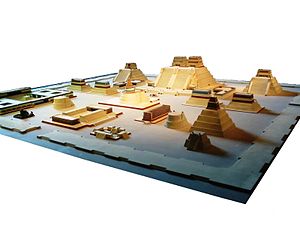
The Pre-Columbian era incorporates all period subdivisions in the history and prehistory of the Americas before the appearance of significant European influences on the American continents. It is spanning the time of the original settlement in the UpperPalaeolithic to European colonization during the Early Modern period.
While technically referring to the era before Christopher Columbus‘ voyages of 1492 to 1504, in practice the term usually includes the history of American Indigenous Cultures until they were conquered or significantly influenced by Europeans, even if this happened decades or even centuries after Columbus’ initial landing. Pre-Columbian is used especially often in the context of the great indigenous civilizations of the Americas, such as those of Mesoamerica (the Olmec, the Toltec, the Teotihuacano, the Zapotec, the Mixtec, the Aztec, and the Maya) and the Andes (Inca, Moche, Chibcha, Cañaris).
Many pre-Columbian civilizations established characteristics and hallmarks which included permanent or urban settlements, agriculture, civic and monumental architecture, and complex societal hierarchies. Some of these civilizations had long faded by the time of the first permanent European arrivals (c. late 15th–early 16th centuries), and are known only through archaeological investigations. Others were contemporary with this period, and are also known from historical accounts of the time. A few, such as the Maya, had their own written records. However, most Europeans of the time viewed such texts as heretical, and much was destroyed. Only a few hidden documents remain today, leaving modern historians with glimpses of ancient culture and knowledge.
According to both indigenous American and European accounts and documents, American civilizations at the time of European encounter possessed many impressive accomplishments. For instance, the Aztecs built one of the most impressive cities in the world,
, the ancient site of Mexico City, with an estimated population of 200,000. American civilizations also displayed impressive accomplishments in astronomy and mathematics. American Indian creation myths tell of a variety of originations of their respective peoples. According to some myths people were “always there”, were created by gods or animals, migrated from specified points, or came from “across the ocean”.

Be First to Comment